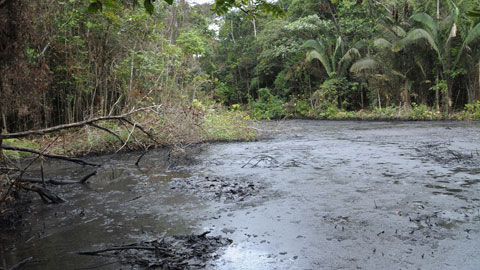Thirty years of oil pollution in the Peruvian Amazon

13/06/2014
Contamination caused by oil drilling has affected Peru's Amazonian region in the past 30 years and represents an important threat to the most pristine and remote areas of this region, according to a study conducted by researchers from the Institute for Environmental Science and Technology (ICTA-UAB) and the UAB Department of Animal Health and Anatomy. For the first time, the study analyses the impact of oil extraction activities in the Western Amazon. The study was presented at the Goldschmidt conference on geochemistry in Sacramento, California.
Most of the world’s tropical rainforests contain oil and gas reserves. Oil production started in the Western Amazon in the 1920s and peaked in the 1970s, but current growing global demand is stimulating a renewed growth in oil and gas extraction. Nearly 70% of the Peruvian Amazon was tapped for oil and between 1970 and 2009.
Now for the first time, the researchers have compiled a database of chemical analyses taken from the western Amazon area over the 1983 to 2013 period, and have analysed occasional and chronic oil spills occurring in different Amazon tributaries. These analyses come from a variety of sources, including Peruvian public agencies and oil companies. Although the data must be backed by more studies, the results have alerted scientists.
“We looked at measurement in 18 wastewater dumping sites from 10 different Amazon tributaries. We were able to pull together records over a 30 year period, from 1983 to 2013, allowing us to measure variations in 9 different pollutants, such a lead, mercury and cadmium. We found that 68% of the samples were above the currently* permitted Peruvian limits for lead concentrations, and 20% of the samples above permitted cadmium levels. We were also able to compare pollution upstream and downstream of some of the dumping sites. With some samples, we found chlorine levels averaged 11 times higher downstream of the wastewater dumping site than it had been upstream", says Raúl Yusta, one of the authors of the study.
“There are no published studies to date that report the pollution impact of oil extraction activities in remote pristine rainforests. Our results show that contamination is widespread in these areas. This increase in pollutant levels is not just due to oil spills, but to the drilling and extraction process. These processes have not been effectively monitored in remote areas until now. Some of this pollution may find its way into the human food chain and certain areas affected by oil spills on land are feeding grounds for large wildlife, including endangered species”, adds Antoni Rosell, ICREA researcher at ICTA and co-director of the study.
Surface water pollution from oil extraction reached this region around 2008, due to the reinjection of formation waters, but little is known about the contamination found in the sediments, soil and possible bio-accumulation of heavy metals in the animals the local indigenous population hunt and fish. This lack of knowledge, linked to a greater demand of fossil fuels, causes great concern for the consequences deriving from new oil exploitation and extraction projects", concludes Martí Orta, also co-director of the study.
The Amazon River has its ultimate source in the 5597m Nevado Mismi peak in the Peruvian Andes. From there is flows down into Peru’s Loreto and Datem del Marañón provinces, which is where these samples were taken. The Western Amazon has large reserves of hydrocarbons in rainforests that host unparalleled biological and cultural diversity.